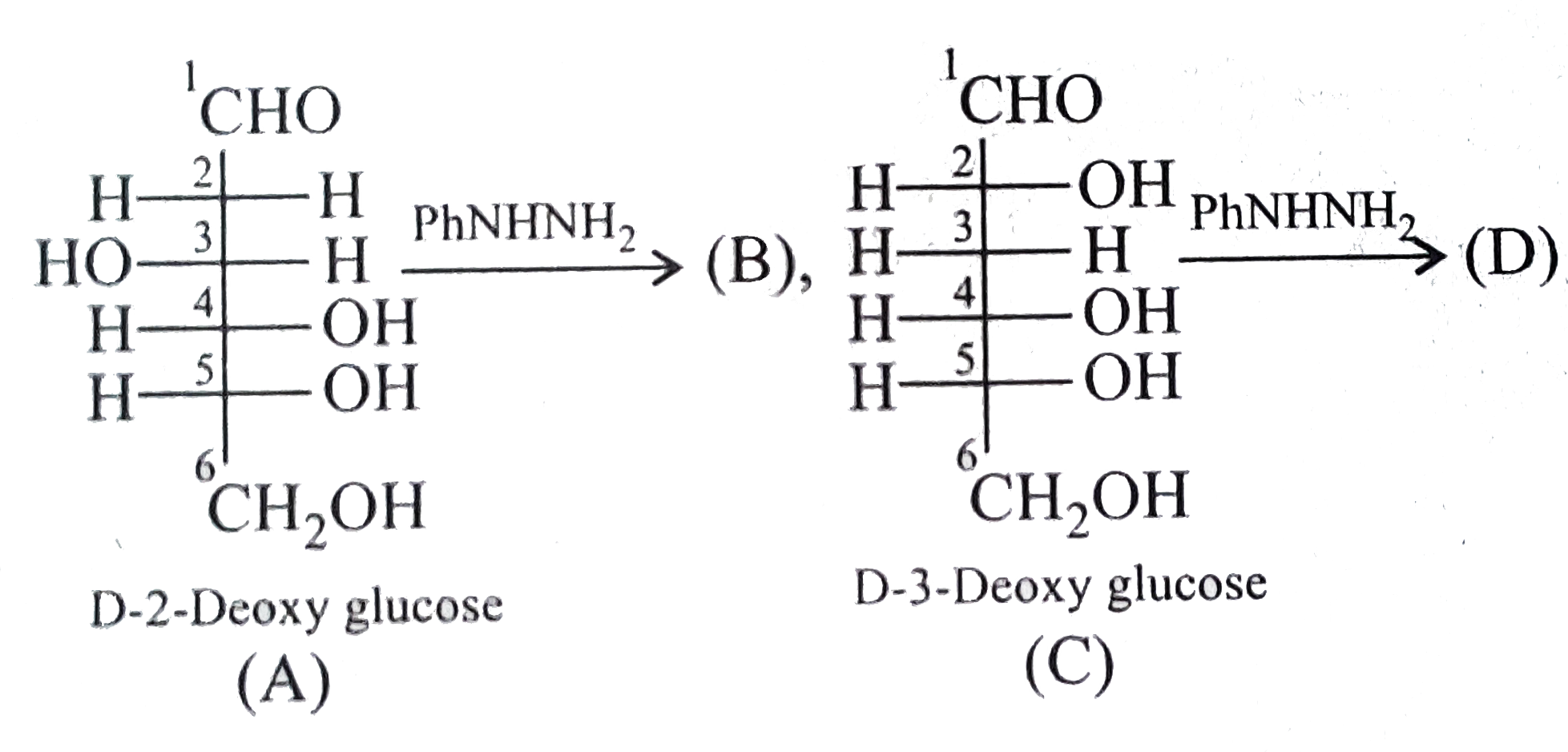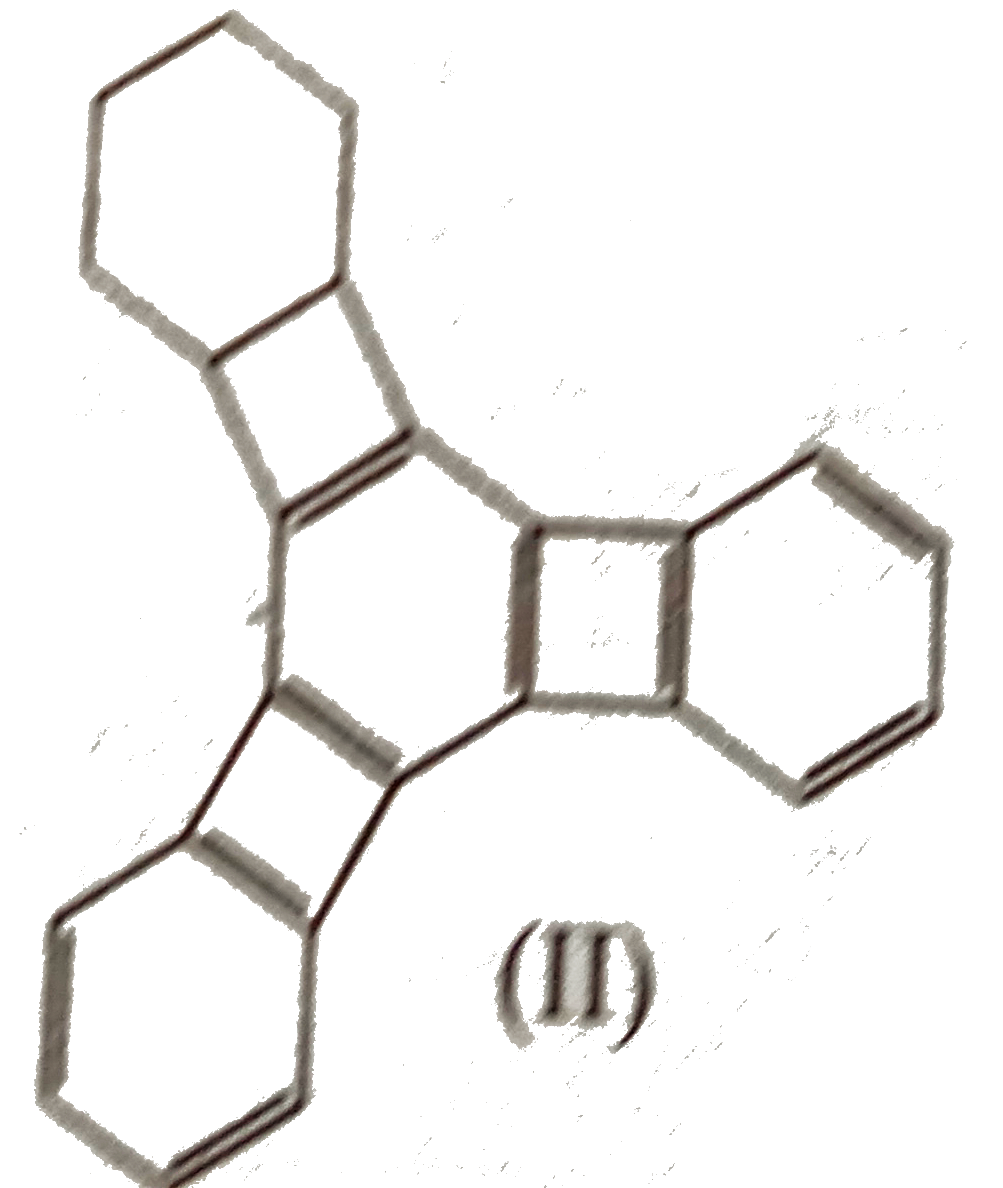Statement I: D−2−Deoxyglucose reacts with 3molPhNHNH2 and form an osazone.
Statement II: D−2−Deoxyglucose has no
(C−OH) group α− to the (C=O) group.
Statement I is true, Statement II is true, Statements II is the correct explanation of Statement I.
Statement I is true, Statement II is true, Statement II is not the correct explanation of Statement I.
Statement I is true, Statement II is false.
Statement I is false, Statement II is true.
The correct Answer is:D
To solve the question, we will analyze both statements regarding D-2-Deoxyglucose and its behavior with phenylhydrazine.
1. Understanding D-2-Deoxyglucose:
- D-2-Deoxyglucose is a derivative of glucose where the hydroxyl group (-OH) at the second carbon is replaced by a hydrogen atom (-H).
- Its structure can be represented as:
CHO−C−H−C−OH−C−OH−CH2OH
- The carbonyl group (C=O) is located at the first carbon (C1).
2. Analyzing Statement I:
- Statement I claims that D-2-Deoxyglucose reacts with 3 moles of phenylhydrazine to form an osazone.
- In reality, osazone formation occurs when a reducing sugar reacts with phenylhydrazine. For glucose and its derivatives, including D-2-Deoxyglucose, only 2 moles of phenylhydrazine are required to form the osazone.
- Therefore, Statement I is false.
3. Analyzing Statement II:
- Statement II claims that D-2-Deoxyglucose has no hydroxyl group (-OH) alpha to the carbonyl group (C=O).
- In the structure of D-2-Deoxyglucose, the carbon adjacent to the carbonyl (C1) is C2, which has a hydrogen atom instead of a hydroxyl group.
- Thus, there is indeed no -OH group at the alpha position relative to the carbonyl group.
- Therefore, Statement II is true.
4. Conclusion:
- Based on the analysis, we conclude that Statement I is false, and Statement II is true.
Final Answer:
- Statement I: False
- Statement II: True
- D-2-Deoxyglucose is a derivative of glucose where the hydroxyl group (-OH) at the second carbon is replaced by a hydrogen atom (-H).
- Its structure can be represented as:
CHO−C−H−C−OH−C−OH−CH2OH
- The carbonyl group (C=O) is located at the first carbon (C1).
- Statement I claims that D-2-Deoxyglucose reacts with 3 moles of phenylhydrazine to form an osazone.
- In reality, osazone formation occurs when a reducing sugar reacts with phenylhydrazine. For glucose and its derivatives, including D-2-Deoxyglucose, only 2 moles of phenylhydrazine are required to form the osazone.
- Therefore, Statement I is false.
- Statement II claims that D-2-Deoxyglucose has no hydroxyl group (-OH) alpha to the carbonyl group (C=O).
- In the structure of D-2-Deoxyglucose, the carbon adjacent to the carbonyl (C1) is C2, which has a hydrogen atom instead of a hydroxyl group.
- Thus, there is indeed no -OH group at the alpha position relative to the carbonyl group.
- Therefore, Statement II is true.
- Based on the analysis, we conclude that Statement I is false, and Statement II is true.
- Statement I: False
- Statement II: True
Topper's Solved these Questions
- BOOK - CENGAGE CHEMISTRY ENGLISHCHAPTER - BIOMOLECULESEXERCISE - Exercises Archives (Single Correct )5videos
BIOMOLECULES
- BOOK - CENGAGE CHEMISTRY ENGLISHCHAPTER - BIOMOLECULESEXERCISE - Exercises Archives (Assertion-Reasoning)1videos
BIOMOLECULES
- BOOK - CENGAGE CHEMISTRY ENGLISHCHAPTER - BIOMOLECULESEXERCISE - Exercises (Single Correcttype)80videos
BIOMOLECULES
- BOOK - CENGAGE CHEMISTRY ENGLISHCHAPTER - AROMATIC COMPOUNDS AND ALKYL AND ARYL HALIDES EXERCISE - Archives Subjective Type4videos
AROMATIC COMPOUNDS AND ALKYL AND ARYL HALIDES
- BOOK - CENGAGE CHEMISTRY ENGLISHCHAPTER - CARBOXYLIC ACIDS AND THEIR DERIVATIVESEXERCISE - Exercises Archives (Analytical And Descriptive)34videos
CARBOXYLIC ACIDS AND THEIR DERIVATIVES
Similar Questions

How manty moles of (C) react with 1molPhNHNH2View SolutionStatement I: D−3 Deoxyglucose has gfour chiral C atoms.
Statement II: It exists in eight stereoisomers.View SolutionStatement-1: Al forms H2 when reacts with NaOH.
Statement-2: Al2O3 is amphoteric by nature.
Statement-3: Al2O3 is a neutral oxide.View SolutionStatement-1: O3 reacts with KOH and forms a paramagnetic compound.
Statement-2: KO3 is paramagnetic.
Statement-3: O2 gives O−2 when heated with Na/NH3View SolutionWrite the structures obtained by the epimerisation of α−D-gluocose at C−2,C−3, and C−4(OH) groups.
View SolutionWhich is true statement about D2O and H2O ?
View SolutionStatement-I : Li2SO4 do not form double salt like alum.
Statement-II : Li reacts with NH3 gas to form LiNH2View SolutionStatement - I : If two sides of a triangle are 4 and 5, then its area lies in (0, 10] Because : Statement - II : Area of a triangle =12ab s∈C and s∈C ∈(0, 1] A (b) B (c) C (d) D
View Solutiona. Statement- 1 and Statement- 2 are true, and state-ment- 2 is the correct explanation of Statement- 1.
b. Statement- 1 and Statement- 2 are true but Statement- 2 is not the correct explanation of Statement- 1.
c. Statement- 1 is true and Statement- 2 is false.
d. Statement- 1 is false and Statement- 2 is true.
e. Statement- 1 is false and Statement- 2 is false.
Statement- 1:
Compound (I) is formed not (II).
 and
and 
Statement- 2:
Due to the reduction of central ring, 3 four-membered anti-aromatic rings become stable to from (I). In (II), due to the reduction of terminal ring, only one anti-aromatic ring can be stabilised.View Solution(a) Statement I is true, Statement II is true , Statement II is a correct explanation for statement I.
(b) Statement I is true, Statement II is true, Statement II is not a correct explanation for Statement I.
(C) Statement I is true, Statement II is false.
(D) Statement I is false , Statement II is true.
Statement I through the point (π,π+1),π<2, there cannot be more than one normal to the parabola y2=4ax . Statement II The point (π,π+1) cannot lie inside the parabola y2=4ax .View Solution

